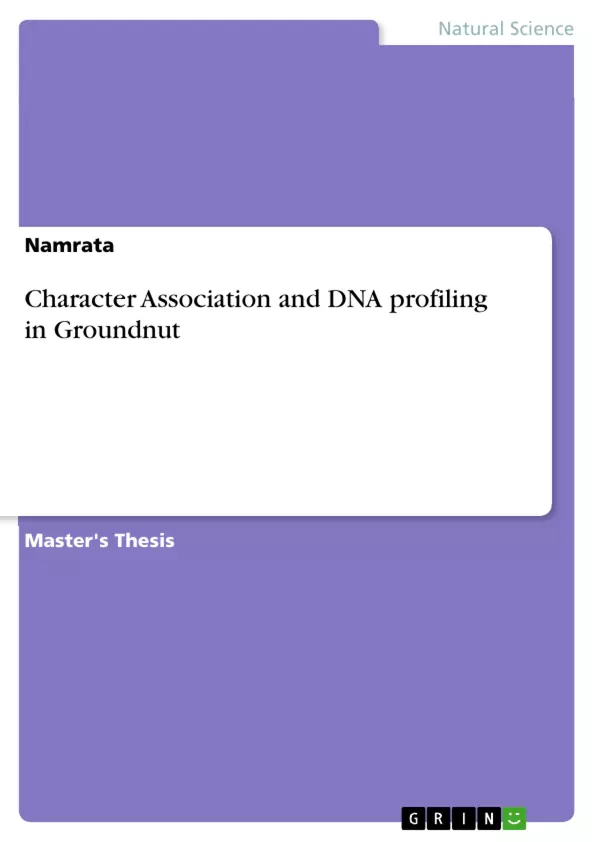Groundnut, the 'king' of oilseeds is commonly known as “peanut” or “monkey nut” or ‘Wonder nut” or “poor man’s cashew nut”. It belongs to subfamily Papilionaceae of the family Fabaceae. It is a self-pollinating crop with basic chromosome number ten and genome size 2800 Mb/lC. Peanut is grown for its high amount of edible oil and a reasonable amount of digestible protein. It is the richest plant source of thiamine and also rich in niacin, which is low in cereals. Peanut is also valuable source of vitamins E, K and B. Groundnut kernels are consumed as raw, boiled, roasted or fried products and also used in a variety of culinary preparations like peanut candies, butter, peanut milk and chocolates. Cake left after extraction of the oil is an excellent feed for livestock. Vegetative parts of groundnut like leaf and stem are good source of nutritionally high quality fodder for farm animals. Groundnut is believed to be originated from South America. Peanut is cultivated around the world in the tropical, sub-tropical and temperate climatic conditions between 40º South and 40º North of equator. The crop is grown in more than 100 countries worldwide. The major groundnut producers are China, India, Nigeria, USA, Senegal, Myanmar, Indonesia and the Sudan. Groundnut is grown on nearly 20.88 million ha worldwide with a total production of 34.66 million tons and an average yield of 1660 kg /ha. Developing countries account for over 97 per cent of world groundnut area and 95 per cent of total production. India is the second largest groundnut producing nation in the world with an area of about 5.53 million ha with a production and productivity of 9.67 million tones and 1750 kg/ha, respectively. Currently, six states viz., Gujarat, Andhra Pradesh, Karnataka, Tamil Nadu, Maharashtra and Rajasthan accounts for more than 90 per cent of the groundnut area and production of the country.
Table of Contents
- INTRODUCTION
- REVIEW OF LITERATURE
- MATERIALS AND METHODS
- Weather data during crop period
- List of genotypes used in present study and their pedigree
- Analysis of variance and expected mean squares
- Analysis of covariance between two characters
- Preparation of stock solutions for DNA extraction and electrophoresis
- Preparation of extraction buffer for DNA extraction
- Detail of RAPD primers used in molecular analysis of groundnut cultivars
- PCR reaction mixture content
- Different cycles of PCR amplification
- EXPERIMENTAL RESULTS AND DISCUSSION
- Mean square for various characters in Groundnut
- Variability parameters for various characters in Groundnut (Arachis hypogaea L.)
- Genotypic and phenotypic correlation coefficients between dry pod yield per plant and other characters in groundnut (Arachis hypogaea L.)
- Genotypic and phenotypic correlation coefficients between kernel yield per plant and other characters in groundnut (Arachis hypogaea L.)
- Genotypic (above diagonal) and Phenotypic (below diagonal) correlation coefficients among different characters in Groundnut (Arachis hypogaea L.)
- Direct (diagonal) and indirect effects of different correlated characters towards dry pod yield per plant in Groundnut (Arachis hypogaea L.)
- Number and Name of Genotypes in different Clusters
- Pattern of amplified product appeared on agarose gel of five Groundnut genotypes with different primers
- Polymorphism information of RAPD primers used
- Details of the random primers used for amplification of genomic DNA of groundnut
- Jaccard similarity coefficient
- SUMMARY AND CONCLUSION
Objectives and Key Themes
This study aims to investigate the genetic diversity of groundnut genotypes using molecular markers. The objective is to understand the relationship between genetic diversity and yield-related traits in groundnut, which can aid in the selection of superior genotypes for improved crop production.
- Genetic diversity among groundnut genotypes
- Relationship between genetic diversity and yield-related traits
- Molecular marker analysis using RAPD markers
- Cluster analysis for grouping genotypes based on genetic similarity
- Identification of superior genotypes for breeding programs
Chapter Summaries
- INTRODUCTION: Provides a general overview of groundnut as a crop, its economic importance, and the need for genetic improvement. It highlights the use of molecular markers in crop breeding programs and the significance of genetic diversity in crop improvement.
- REVIEW OF LITERATURE: Presents a comprehensive overview of existing research on the genetic diversity of groundnut, various molecular markers used for its assessment, and the relationship between genetic diversity and yield-related traits. This chapter provides a thorough review of the literature related to the study's objectives.
- MATERIALS AND METHODS: Describes the materials used in the study, including the groundnut genotypes, experimental design, and the procedures followed for data collection and analysis. It details the methods employed for DNA extraction, RAPD marker analysis, and statistical analysis of the data.
- EXPERIMENTAL RESULTS AND DISCUSSION: Presents the results of the study, including the genetic diversity analysis, the relationship between genetic diversity and yield-related traits, and the identification of superior genotypes. The chapter provides a detailed discussion of the findings, drawing connections to previous research and explaining the implications of the results.
Keywords
This study focuses on groundnut, genetic diversity, molecular markers, RAPD, cluster analysis, yield-related traits, and crop improvement. The research uses molecular techniques to assess genetic diversity and its relationship with yield-related traits in groundnut genotypes, ultimately contributing to the development of superior genotypes for breeding programs.
- Quote paper
- Namrata (Author), 2015, Character Association and DNA profiling in Groundnut, Munich, GRIN Verlag, https://www.grin.com/document/444451



